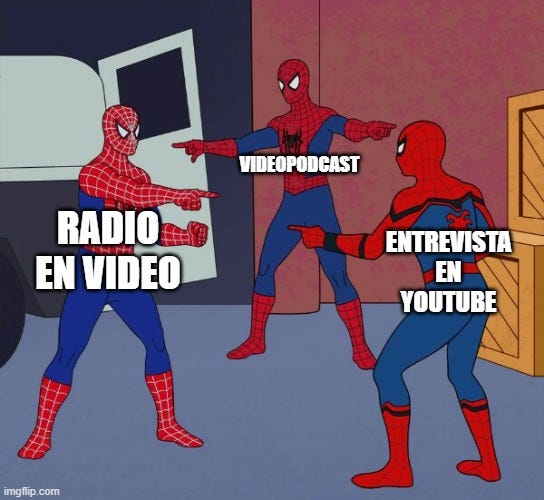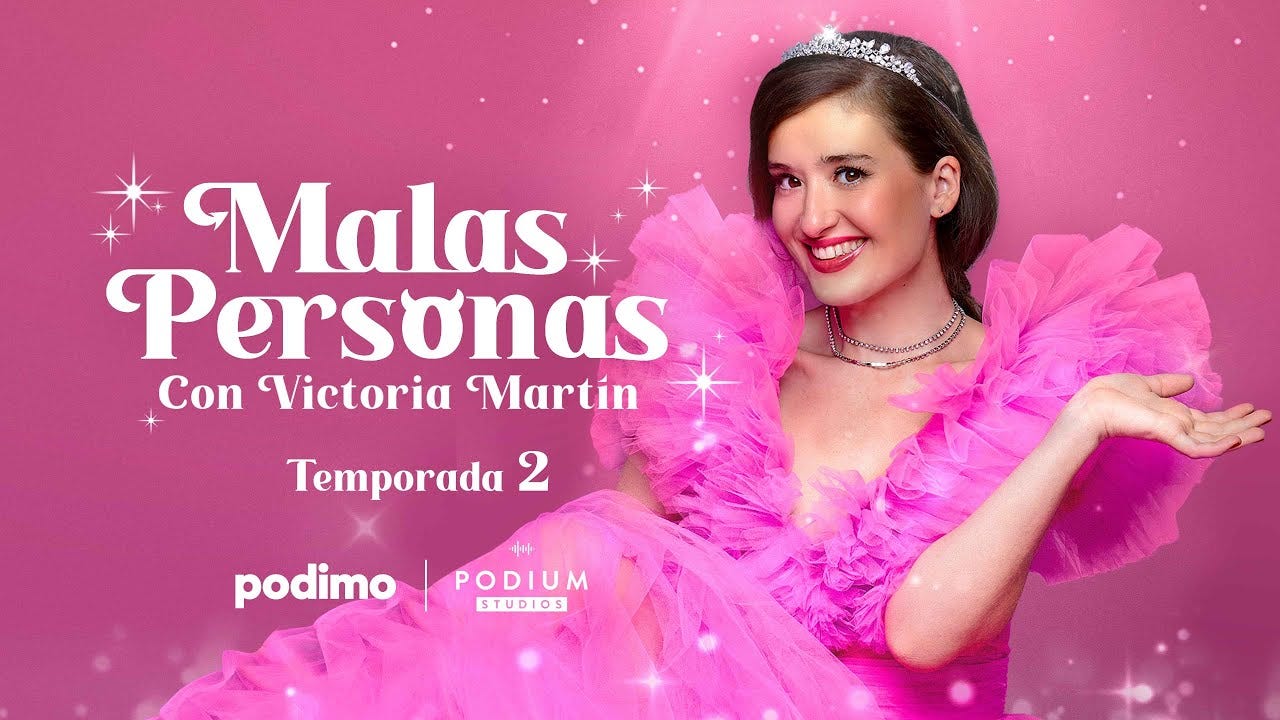The videopodcast paradox
What a videopodcast is and what is not, plus, interview with the producer of the first awarded videopodcast in Premios Ondas (Spain) history.

It’s time to shine :)
I’m writing from Spain, three beautiful projects have taken me across the world in the last month: Estación Podcast Festival (Madrid), Soroche audio performance live (San Francisco), and next week the biggest Spanish-language podcast awards: III Premios Ondas Globales del Podcast (Madrid).
I am very excited. As a member of the jury for Los Ondas this year, one of the things that caught my attention was the new video podcast category. So today I’m writing about it. I spoke with María Jesús Espinosa, Agustín Espada and Nacho Pardo (producer of "Malas Personas" winner for Best Video podcast) about the rise of this format.
But first, an update:

Soroche’s live performance was incredible. Thanks to Two Line Press and Cuentero Productions, this show presented a Mónica Ojeda’s short story in English, for more than 100 people. The story is about four friends that hike in Los Andes and altitude sickness brings the worst of them. Guided by Camilo Garzón’s direction, this show meant a personal turning point for me: I waived goodbye the “maybe I don’t speak English perfectly enough” complex. I read the story, helped cast the voices, co-directed the recordings and then cutted the first rough mix. Then was directed as an actress and after the podcast was done, I was invited to Brava Theatre to perform live and I did it. :) My character was Nicole, a self-righteous woman.
Moral: I’ll speak English with a Latin accent always, but that doesn't mean that " I don't speak well". The barrier was mostly self-imposed. First, it's about simply speaking and being understood. Secondly, it's about being completely me in another language. That's what I take away from this project. Thanks to the Center for the Art of Translation, Two Line Press, Cuentero, the audience and of course the amazing audio team behind this. Shoutout to Catherine Girardeu, Daniel Murcia and María Linares.
Soroche is part of a book called “Through the night like a snake” featuring horror fiction stories from LatinAmerica. The audio version is expected to be released this year, I'll tell you about it as soon as it comes out. OK, we’re ready for this…
The videopodcast paradox
If I were to start looking for the first video podcast I would have to go back to the old Apple archives to 2009, when the first audios/videos were uploaded to iTunes. I'd probably find video podcasts of education or tv features, but I doubt I'd get to the first one ever. Ever since podcasting was born, video podcast was too, (remember that the reason why people uploaded audio only was also because it used less internet speed).
As the production and demand of native digital content has evolved, the lines between audio and visual have become increasingly blurred, until today they almost feel synonymous in certain scenarios. Many people think that having a podcast is interviewing on camera. And I don't think it's all the same. I don't pretend to make the ultimate definition of what a videopodcast is but I do want to understand what producing one is all about and where the line needs to be drawn between visual radio, videopodcast, and a YouTube channel.
Video podcasts are the most aspirational format for new podcasters. This year, for the first time ever, they have their own category in the Ondas Globales del Pódcast. María Jesús Espinosa, President of the jury of the Ondas Globales del Pódcast Awards explained the decision to me:
“We tried to keep the awards as close as possible to the mutations experienced by the growing podcast industry and we realized that the number of video podcasts, essentially in the field of conversational ones, was growing exponentially. And, above all, they were being widely consumed by members of generation Z, who were also discovering them on TikTok. The truth is that time proved us right and it has been one of the categories with the highest number of nominations.”
It has been a success. Many people have production, community, and business models with their video podcasts. But it's not the same as producing other video-on-demand formats. The first way to draw the line is its language (visual/audio).
“The definitions and limits are not clear. But if I had to risk a limit, is that the language that has more weight. If one can understand it just by listening to it, then it is video podcast and visual radio (...) If the image has a greater weight than the sound, then it is not video podcast." Agustín Espada, Research Professor.
The point of making a video podcast is for the podcast to have a visual accompaniment and thus impact more audiences. If we follow Espada's logic, we could say: that in videopodcasting the sound language must have more weight than the visual one. Secondly, the line must also be drawn in terms of format. I talked about this with Nacho Pardo (Living Producciones), producer of the winning 2023 videopodcast "Malas Personas".
“Basically what is different is the format. I think what the podcast brings to YouTube (and this is a bit cold and maybe a bit ugly) is audience retention.”
Pardo and Victoria Martín (Host of the show) are TV professionals, working with late-night shows in Spain. When they started their YouTube channel, they kicked off with 3-4 minutes long humor sketches. Their main concern was to keep people's attention. They premiered their first TV series ("Válidas") during the pandemic and after five episodes Victoria started making the joke "How long are we going to keep stretching the gum?” (¿Hasta cuando vamos a seguir estirando el chicle?) That's where the name of their first video podcast came from “Estirando el chicle”. They studied the market and concluded that this format, rather than 3-minute sketches, was their best bet.
“Suddenly, it turns out that if you have a conversation (on video), people watch it for an hour or more. In Jordi White's case (an influencer from Spain), four and five hours of conversation. Personally, this is something that I care a lot when it comes to winning the best videopodcast award, which is, okay, yes, anyone can make a podcast, okay (...) but today, I do not watch a podcast that has the audio recorded with a cell phone or the video recorded with a cell phone, that is, to make "Malas Personas" I think it we have a quality that looks pretty good, that sounds pretty good, but it has taken us a lot of work. 24 people are going to the Awards with us. We are a lot of people."
For Nacho it's not about just sitting down and talking, it's about three things: good visual production, good audio production, and an excellent engagement. Whoever is on the microphone must capture your attention and keep it. Like Victoria. It's fundamental because a video podcast is maintained thanks to its metrics. Sponsorship and growth of the show depends on it. The last frontier would be the budget it takes to make it. Nacho comments:
“You can make a podcast that has a 10,000 euros budget, which for a podcast seems like a lot of money. And yet a TV show that costs less than 90 or 100,000 euros per episode is a very cheap TV show. And this is where, as producers, we have to raise our hand and say "hey, but be careful how you manage this."
As a video podcaster, the more you invest in gear, art direction, visual production, etc, the more it would look like a TV show… but still with a podcast budget. That’s the worst-case scenario.
“From the first season to the second, we took a qualitative step forward in art, lighting, technique and everything. During the third season we had a conversation with the team that we said 'damn, let's see what we can do to take it a step further for the fourth season'. When we had this conversation, I said guys, no. To me, we've reach the ceiling. We can do better, of course we can (...) but by the time you're 14 episodes in, you're going to be up to your eyeballs and you're going to regret it."
With no added budget and less profit margin, the cost of raising the bar will be burning out your team. This practice also creates a misperception that a “video podcast is worth the same as a TV show”. And because of these wrong ideas we end up having Spotify’s CEOs saying that “the cost of creating content is close to zero”. If we don’t explain and calculate the value of making our content, no one will. Calculating the time and talent that it takes to make every episode is the only solution to produce in good faith. A good practice not only for the video podcast but for any on-demand digital content.
The production process of an episode of "Malas Personas", winner of the Global Ondas Award for Best Videopodcast 2023.
Define who’ll be the guest and the interview angle
Book the interview
First script of the opening monologue. Define the list of questions. Sending two questions that are always asked in this show to the guest.
Book hair and make-up
Set up the interview set.
The day before the interview, lighting and cameras must be ready to record.
Recording the monologue.
Recording the interview.
Log the material. First technical edit
First edit, selection of short videos for social media.
Second edit. Social media manager approves.
Review by Victoria, new edits (as needed).
Videos for social media ready
Videopodcast sent for publication.
Note: Audio is edited at the same time video is, except from video for social media.
Reaching a first conclusion
It is necessary to draw frontiers between a video podcast / a podcast / and a tv interview show. The three ideas I contribute are:
Audio language (voice, music, SFX) should be more important than visual language.
A video podcast should have good visual production, good audio production, and excellent engagement.
The production budget should be less than that of a TV show.
I insist: my mission is not to reach the only definition of video podcast. Do you think other rules can help us define this format from the others?
Comment on this by scrolling down or via @lauraubate on Instagram.
My new podcast’s trailer. Full season September 25th, 2024.






